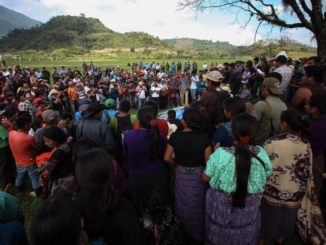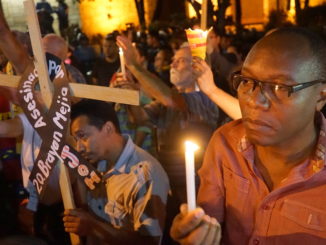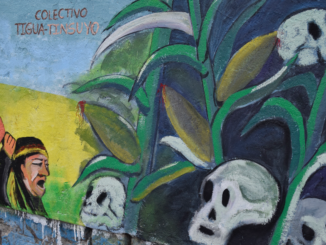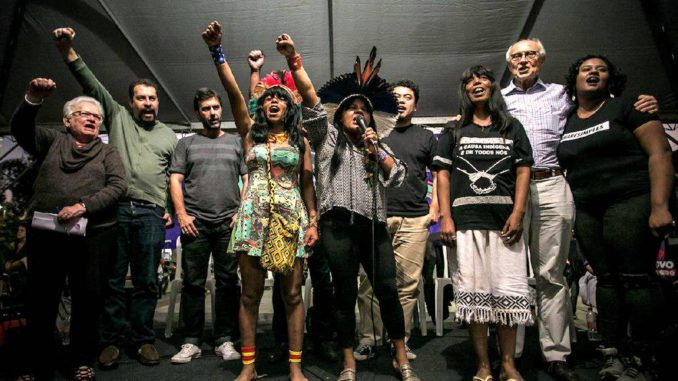
One of the biggest certainties surrounding the Brazilian Left is that it has to take base-building tasks more seriously if it wants to recapture its popularity and relevance. The current government is illegitimate and widely unpopular, yet resistance to it is contained to sporadic protests in main cities. None of these protests have come close to ousting President Michel Temer yet, and this has caused concern in the left over questions of how to organize resistance under a right-wing attack and how to promote conversations around a progressive political project in Brazil. Whereas this project cannot simply fulfill electoral purposes, a sense of urgency tied to the 2018 elections has led the left to think of the need to reconnect to the base.
In the classic sense, base-building deals with approaches that connect the political vanguard, such as the party leadership, to the working class. This was done for a long time through labor union politics as a direct way to organize the working class and its demands. With the precarization of work and an increased demand for the left to deal with more issues outside of the workplace, building a base must include a plethora of tactics. If it aims to be effective beyond electoral purposes, base-building must also match self-organizing principles and increased political participation with politicizing efforts so that the masses can become political subjects, rather than just political objects.
Currently, base-building in Brazil also has to take into account the people’s disillusionment with the left, especially with what the Workers’ Party (PT) has become and what could happen if Luiz Inácio “Lula” da Silva was to return as president. Besides the neoliberal policies of his government, even the gains thought to have been achieved during the PT governments are at the risk of being undercut by new contradictory information. For instance, Thomas Piketty’s latest analysis points out that the PT did not reduce inequality as much as once thought and that, in fact, most of the income redistribution happened between the middle class and the lower classes, leaving the ruling groups untouched or enriched.
Although the mass protests of June 2013 – a movement sparked by a widespread rejection of public transit fare hikes that later expanded into a swell of protest against a myriad of issues, from police brutality to corruption – marked a new conjuncture, the left has still struggled to represent the people in the streets to the point of being able to bring them back to the marches against the Temer government. The two major fronts, Frente Brasil Popular (moderate left) and Frente Povo Sem Medo (radical left), called for protests before and after Rousseff’s impeachment, but attendance varied. The radical left has been left questioning why the people are not taking to the streets in huge displays of revolt after Temer’s many regressive reforms, such as the Pension Reform and Workers’ Rights Reform, and corruption scandals. Some wonder how long it will take – or what regressive policy it will take – before widespread rebellion ensues.
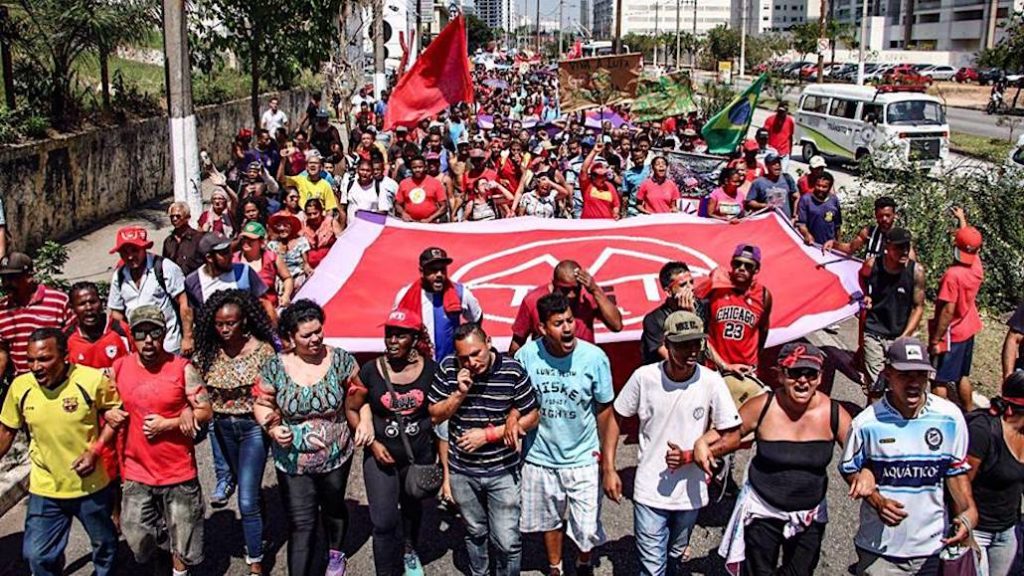
But the political situation is not that simple, and in reality there are many factors that have contributed to the decline in popular support for the left and a general process of depoliticization. The gains made by the right in the face of the PT’s first signs of decline, as well as the demobilization that the PT encouraged in order to maintain power without confrontation over its alliances with the elites (particularly banks, construction conglomerates, and agribusiness) have played a part in growing lethargy and mistrust. Even though a new generation has become more politically engaged since 2013 and the radical left has indeed expanded its numbers since then, the growth is still marginal and has not led to the popular mobilization necessary to challenge Temer and his reforms.
Which way does the left turn?
Talking about the need for more base-building is not the same as actually engaging in more base-building. One method of self-organizing that has emerged has been occupations in response to urban crises of homelessness, poverty, and inequality. The Homeless Workers’ Movement (MTST), which has only recently gained national relevance despite being around since 1997, is an example of base-building around right to the city issues. The movement is considered to be the leadership behind Frente Povo Sem Medo, and its rejection of conciliatory and placating politics, together with its critique of the PT governments for its pivot toward neoliberalism, positions the MTST as credible a social movement leader of the radical left that can mobilize large numbers. This is more than any of the parties of the radical left can do, even the PSOL, which is the largest and most visible of them, particularly due to its parliamentary presence. Because of this mobilizing capacity, the MTST has acted as a center of gravity for the radical left, making political parties from the PT to PSOL eager to court it and its grassroots power.
But this struggle over the MTST and its popular support is not without contestation. One point of contention was the launch of the online platform Vamos!, a platform led by the Frente Povo Sem Medo and inspired by the online forums spearheaded by Podemos in Spain. The initiative is not completely novel in Brazil, since similar websites were used in the past, including to collectively build the mayoral campaign of the PSOL’s Marco Freixo in Rio de Janeiro in 2016. What is interesting about Vamos! though, besides how it connects Podemos and the Frente Povo Sem Medo, is how the platform system – through which users can agree with, disagree with, or pass on fellow users’ pitches around six preset political axes to inform local debates around the country – was first seen as controversial by radical left actors because of its potential to build a bridge between the Frente Povo Sem Medo and the PT.
Whereas Vamos! could popularize an online tactic for base-building, the potential hijacking of the platform for electoral purposes by the PT poses the risk of significantly skewing the results.
Frente Povo Sem Medo is made up primarily of the MTST, organizations and collectives tied to the PSOL, as well as the Brigadas Populares, the union Intersindical, and other actors. The Brazilian Communist Party (PCB) has also promoted resistance alongside the front, since political parties do not participate in it directly. The platform, however, brought hope that discussion around a new project for Brazil could encompass even more organizations than the front, such as the Unified Socialist Workers’ Party (PSTU). Yet, reactions around the PT’s proximity to Vamos! have actually made some actors more wary of what could come out of the platform and its debates. As soon as the platform was announced, critics were divided between analysing the potential of such an online initiative, including the assumptions behind online tools and democratic participation, and the involvement of the PT in an initiative by a front closely linked to the radical left. PT representatives were quick to promote and compliment Vamos! and were seen as potential contributors to the project. But why is this so controversial that it warrants direct criticism?
First, it is important to consider how the national status of Vamos! means bringing difficult conversations around policies and more socially just society to the forefront. At a time when the masses are still so distant from the leftist organizations, initiatives such as this one must be congratulated. Vamos! has the potential to increase awareness about a variety of issues in Brazil and perhaps even to strengthen new political voices.
Whereas Vamos! could popularize an online tactic for base-building, especially due to its focus on listening to pitches and demands and then running the most popular ones through political leaders and specialists, the potential hijacking of the platform for electoral purposes by the PT poses the risk of significantly skewing the results.
Attacks on workers’ rights have heightened under Temer, but they were also a concern during Lula’s and Rousseff’s terms. Despite the division between a moderate and a radical left – explicit in the presence of at least two fronts of resistance (not all radical left organizations contribute to Povo Sem Medo and some have argued for the creation of a socialist front) – the assault on the working class has demanded collaboration. All of the left, including leftist organizations that played a part in class conciliation, should resist together for the benefit of their bases and the masses they aim to organize.
However, Vamos! is not a platform of resistance, but rather one for formulating political programs and, many suspect, for building viable candidacies for the 2018 elections. Critics argue that the enthusiasm of the PT around Vamos! is worrisome because it blurs the line between joint popular resistance and joint programmatic discussions, including electoral projects. This is in fact one of the premises behind the collaboration between the two fronts, Brasil Popular and Povo Sem Medo, in recent protests. This collaboration, based on minimum agreements, instead prioritizes the need to fight the setbacks with as much unity as possible, but without a programmatic overlap, since the moderate and the radical left have vastly different political projects for the country. Because Vamos! forwards discussions on matters such as the right to the city, some wonder if it is possible to maintain independence and critique the PT on topics that caused conflicts between social movements and the PT governments. One example is the question of how to advance a conversation on a housing program for the country with members from a party whose own housing program favored large construction conglomerates. Will the PT actors who were so enthusiastic about Vamos! keep their enthusiasm if it means promoting policies that undercut the PT’s strategy of class conciliation?
Suspicion regarding the answer to this question heightens when considering that the PT has developed a reputation for co-opting social movements and taking advantage of grassroots base-building work only to make its own project visible. With word of Lula 2018 in the streets, it is worth questioning whether the party is only interested in Vamos! because of its potential to appeal to a collectively-made campaign that can bring legitimacy to the PT after a wave of rejection caused by disillusion, hate, and the crisis of representation and not the aspects that could strengthen base-building efforts toward creating a radical left alternative to the PT. Still, radical left organizations that contribute or collaborate with Povo Sem Medo have bet that the best way to to ensure political independence in Vamos! and the necessary space for critique of the PT is to build the platform as intensively as possible.
So far, the platform has contributed to a few events, and despite the presence of PT members, official Frente Povo Sem Medo contributors have been in the spotlight. Participants have found the debates to be interesting, though it is still unclear whether they can actually contribute to larger programmatic discussions that would shape political projects in the radical left. In fact, part of the concern is that if Vamos! cannot achieve its stated objectives of program development and widespread base-building, will it become nothing more than an electoral conduit? The process is still new and should not be dismissed solely over fear of co-optation and opportunistic interference in the left. Yet, it should definitely be critiqued as constructively as possible given everything that is at stake in 2017 and 2018, which is not simply the viability of a leftist candidacy, but the viability of the leftist project itself.
Sabrina Fernandes has a PhD in Sociology from Carleton University. She is an activist in the Brazilian radical left and is the producer behind the radical left YouTube Channel À Esquerda.
Copyright, Upside Down World. May not be reprinted without permission.

